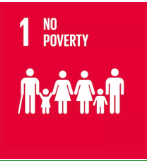In 2016, The United Nations adopted the Sustainable Development Goals – a set of targets for all countries to meet by 2030. These targets address the global challenges being faced, including those related to poverty, inequality, climate, environmental degradation, prosperity, and peace and justice. Target 1 is ‘No poverty’:
1.1: By 2030, eradicate extreme poverty for all people everywhere, currently measured as people living on less than $1.25 a day
1.2: By 2030, reduce at least by half the proportion of men, women and children of all ages living in poverty in all its dimensions according to national definitions
Target 1.2 requires all countries to measure:
1.2.1: ‘Proportion of population living below the national poverty line, by sex and age’.
1.2.2: ‘Proportion of men, women and children of all ages living in poverty in all its dimensions according to national definitions’.
Why use the consensual approach?
The
consensual approach provides an important tool for measuring progress in reducing multi-dimensional poverty (target 1.2). It covers all the different domains of poverty (food, health, education, housing and household goods, services, activities, social obligations etc) using nationally specific standards as set by that society (1.2 and 1.2.1). The method produces poverty measurement for men, women and children, as well as at the household level (1.2.2). It helps identify the causes of poverty by providing analysis by socio-economic and geographical variables of overall poverty and for the different domains of poverty and the degree of severity of poverty. This helps identify targeted policy interventions as well as overall policy programmes.
Under the world regions (above) you will find reports detailing the use of the consensual approach in countries in that region. Academic papers that discuss the use of the consensual method to meet these development goals are listed below and in the left hand menu you will find more details on '
Implementing the Consensual Approach' and the use of the consensual approach in the work of
International Agencies.
The key advantages of the consensual approach for measuring progress in meeting the SDG target 1.2 are that it:
- Allows for an examination of the multi-dimensional nature of poverty
- Has been tested in low-, middle- and high-income countries
- Examines deprivation and resources (not just income) to provide an overall measurement of poverty
- Uses standards set by the society to which they are applied
- Is based on the current needs of the population
- Reflects people’s experiences of poverty in the society to which it is applied
- Does not impose minimalist standards
- Has a clear democratic justification for standards used
- Has age-related standards for adults and children
- Is based on statistically valid, reliable and comparable indicators of deprivation
- Collects data specifically to measure poverty which can be collected easily as part of existing survey programmes
- Enables measurement for men, women and children seperately
- Allows for socio-economic and geographical analysis
- Incorporates easily produced standardised output tables
- Is not based on arbitrary equivalence ratings for different types of deprivation
- Provides for international comparisons between low- middle- and high-income countries
- Reflects internationally accepted definitions of poverty
- Based on theory developed over 40 years of poverty research
The presentation below on 'Measuring Poverty' made by Joanna Mack, Alba Lanau and Shailen Nandy to the Tonga Statistical Conference in April 2018 provides an overview on how the consensual method of measuring poverty can help meet SDG goal 1.2. The presentation on 'Foundations of the consensual approach', made by Joanna Mack to the University of the South Pacific in April 2018, provides additional details.
Key reading
In a CROP briefing on '
The consensual approach to child poverty measurement' (pdf) Shailen Nandy and Gill Main argue that this approach provides an important alternative the narrow, minimalist definitions of poverty dominating conventional international measures. Download pdf below.
'What Works for Africa’s Poorest Children? From Measurement to Action' identifies the social policies and programmes that are most effective in supporting Africa’s poorest and most vulnerable children, including coverage on how the consensual approach can be used to identify child poverty and deprivation and formulate child sensitive policy interventions. Edited by David Lawson, Diego Angemi, Ibrahim Kasirye, and published by Practical Action (2020), it is free to download.
Author: Joanna Mack




 PSE:UK is a major collaboration between the University of Bristol, Heriot-Watt University, The Open University, Queen's University Belfast, University of Glasgow and the University of York working with the National Centre for Social Research and the Northern Ireland Statistics and Research Agency. ESRC Grant RES-060-25-0052.
PSE:UK is a major collaboration between the University of Bristol, Heriot-Watt University, The Open University, Queen's University Belfast, University of Glasgow and the University of York working with the National Centre for Social Research and the Northern Ireland Statistics and Research Agency. ESRC Grant RES-060-25-0052.






